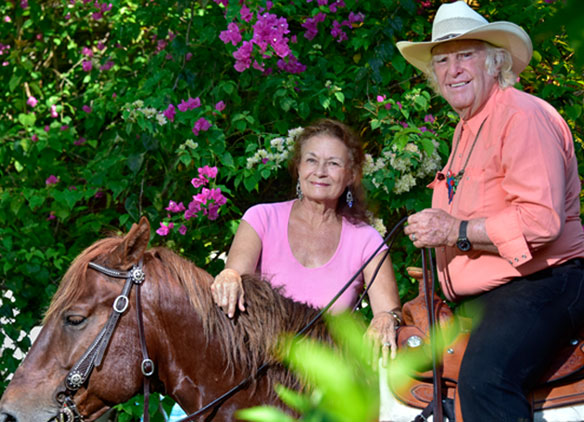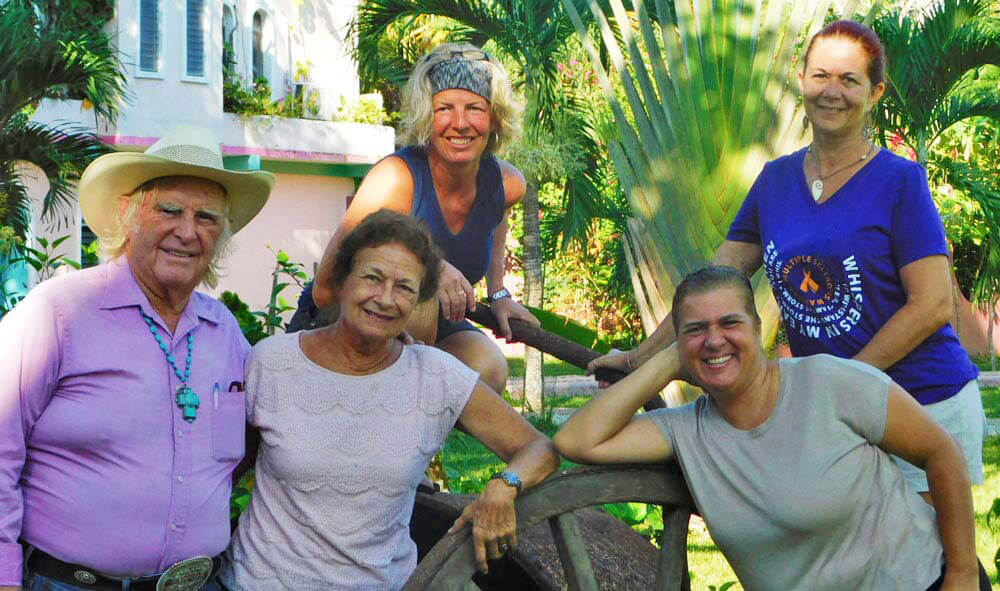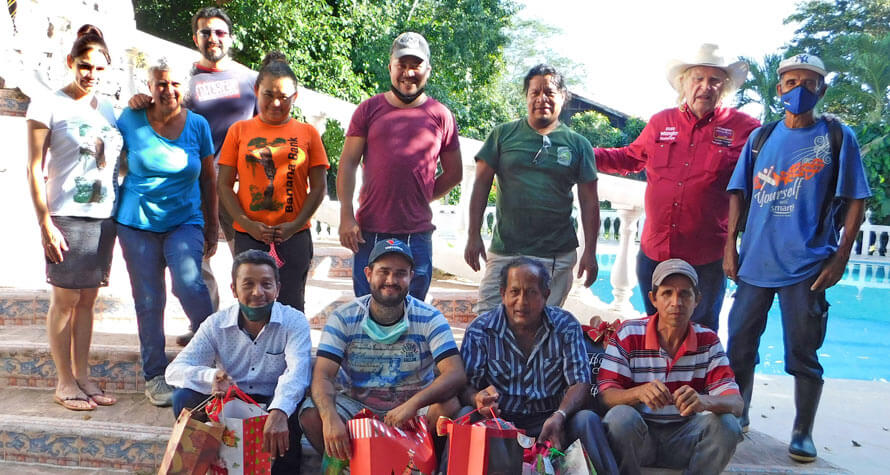









 In 1973 when John Carr and his partner Bill Jaeger came to see Banana Bank they were enchanted immediately and bought it two weeks later. The place looked anything but prosperous. The country was struggling to escape the clutches of a tired and inattentive colonial system.
In 1973 when John Carr and his partner Bill Jaeger came to see Banana Bank they were enchanted immediately and bought it two weeks later. The place looked anything but prosperous. The country was struggling to escape the clutches of a tired and inattentive colonial system.
The economy was faltering. Fences were broken down. A work force of 30 men barely kept the pastures chopped with machetes and were paid $2 a day. The place, however, had a beauty that was captivating. The Belize River had a personality like a fickle lover wrapping its arms around the property affording it 20 miles of riverfront. It reached into the heart of John. He was raised on a ranch in Montana and knew nothing about the tropics but he knew there were no 40 degrees below morning with ice to chop off the water tank so he figured he could learn.
John packed up his wife and two daughters in a used GMC U-Haul box truck with all their earthly belongings and drove the 1400 plus miles from Leoti, Kansas to Belmopan Belize and began life at Banana Bank Ranch which in those days was solely a cattle ranch.
In its “glory days” Banana Bank had been a logging and frontier outpost, the last stop on the Belize River before heading into the wilds of the unsettled hinterland. There was even a horse race track at Banana Bank and the barons of the logging and chicle industries found pleasure in challenging each other with their best horses, some even having come from Jamaica and beyond but by the time the Carrs arrived, horse racing had long since vanished at Banana Bank. About the only remainder of the glory days was a huge black stallion and a few mares that came with the ranch along with 1500 heads of cattle. The stallion’s name was Nigger. Thinking his name entirely inappropriate and offensive we tried to change it to Midnight. Nigger, however, was known throughout the country as an outstanding horse and it was impossible to change his name.
Today, John, Carolyn and their two daughters Leisa and her husband Rony, and Victrie, live at Banana Bank. The property has evolved from a cattle ranch to a farm, a teak plantation, a hotel and yes, we still run a fine herd of simbrah cattle along with about 80 horses.

 In the 1800’s logging was the main thrust of the economy. The only way to the interior was by boat and people spoke of the jungle in hushed tones. Banana Bank was an outpost of this forbidden land on the Belize River. The colonial system was to award certain companies huge tracts of land with logging rights in exchange for support for the crown. Banana Bank was part of just such a property which by the 1940’s was known as the Belize Estates Corporation.
In the 1800’s logging was the main thrust of the economy. The only way to the interior was by boat and people spoke of the jungle in hushed tones. Banana Bank was an outpost of this forbidden land on the Belize River. The colonial system was to award certain companies huge tracts of land with logging rights in exchange for support for the crown. Banana Bank was part of just such a property which by the 1940’s was known as the Belize Estates Corporation.
From February to June, the logs were cut and dragged to the company headquarters along the Belize River. They were sorted, branded and lashed together in large rafts, awaiting the rains that flooded the river enabling them to float to the sea.
Such gathering sites for the logs were called barquadiers. As well as a barquadier, Banana Bank was a headquarters for the owners of the company, Belize Estates Corporation. It was a place to come and find a good meal, exchange news and get a good night’s rest. Stories were embellished by those coming from the city and others coming from deep within the jungle where the logs were found. It was a place of refuge from the hardships of the jungle and of excitement for those thirsty for a taste of adventure. A newspaper article from the Clarion in 1910 designated Banana Bank as a place of great hospitality and intrigue.
The logging operation depended on the transfer of logs first of all from the bush to the river, which was usually accomplished by oxen. These same oxen when old or wounded were used to feed the workers. If there was no river then in certain parts of the country, small rail lines were built. One such rail line was built in the early 1930’s going from Gallon Jug to Hill Bank, another outpost of the logging era. There was a short set of tracks on Banana Bank as well.
A train station was built at Gallon Jug around 1910 and used until the 40’s when heavy trucks replaced the small rail lines for transporting logs. Around 1945 the train station was broken down in panels and transported by truck to the New River, loaded onto a barge and carried down the river to the Caribbean Sea. The panels were loaded on a boat at Corozal and taken all the way to the mouth of the Belize River then up the river to Banana Bank. This is a distance of some 350 miles. It is only about 25 miles from Gallon Jug to Banana Bank as the crow flies. As improbable as it may seem, it actually happened.
By the mid-40’s the purpose of the ranch had shifted from logging to cattle and a large herd was maintained. There was also a remuda of some 50 horses. Largely due to the flamboyant nature of the managers of the day, Banana Bank was known countrywide as a place to come for a jolly good time and anyone involved with horses spent time there. The train station headquarters was the main house. Painted green, it stood in low profile against huge rain and ceiba trees. It wrapped itself around some stories that can’t really be told except in reverence because of their personal and delicate content. Other stories must be told. They are too good to keep.
A racetrack evolved and during the dry season, horses were brought across the river at a shallow point near Little Orange Walk. In the 50’s and 60’s horse races were held at Banana Bank on a regular basis and the ranch was famous countrywide for its horses and horsemen. A horse named Warrior Chief is still talked about today in racing circles. It might be mentioned here that the cattle foreman was a woman named Patricia, the pretty Scottish lass with flaming red hair, daughter of the manager, John Shaw. When the John Carr family arrived at Banana Bank in 1977 after having purchased the ranch in 1973 along with their business partner, Bill Jaeger, the logging days and days of rowdy fun were long gone. What was to lie ahead was the rebuilding of a broken down ranch, the victim of the transition of power from a tired English mother country to the poor struggling step child of the Crown. What a challenge it has been but one we have embraced and overcome.
 Banana Bank is all about family and our staff is our extended family – some are even second generation! When you communicate with our office you may be talking to Silvia or Anne.
Banana Bank is all about family and our staff is our extended family – some are even second generation! When you communicate with our office you may be talking to Silvia or Anne.
Our cowboys are eager to meet you and take you on memorable rides throughout the many trails at Banana Bank. Cesar, Sherman, John and Chico will show you the joy of riding through the jungle horseback. All our cowboys not only conduct the rides, but they train as per horse whispering methods and John Carr horsemanship practices, all our born and bred Banana Bank horses.
All our meals are prepared and served family style. Rosario is our head cook and is ready to prepare delicious local and American dishes. Please let us know if you have any special requests or dietary restrictions.




